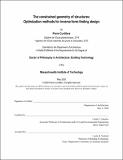| dc.contributor.advisor | Caitlin T. Mueller. | en_US |
| dc.contributor.author | Cuvilliers, Pierre(Pierre Emmanuel) | en_US |
| dc.contributor.other | Massachusetts Institute of Technology. Department of Architecture. | en_US |
| dc.date.accessioned | 2020-10-08T21:27:15Z | |
| dc.date.available | 2020-10-08T21:27:15Z | |
| dc.date.copyright | 2020 | en_US |
| dc.date.issued | 2020 | en_US |
| dc.identifier.uri | https://hdl.handle.net/1721.1/127853 | |
| dc.description | Thesis: Ph. D. in Architecture: Building Technology, Massachusetts Institute of Technology, Department of Architecture, May, 2020 | en_US |
| dc.description | Cataloged from PDF version of thesis. | en_US |
| dc.description | Includes bibliographical references (pages [133]-145). | en_US |
| dc.description.abstract | This dissertation aims to improve form-finding workflows by giving more control on the obtained shapes to the designer. Traditional direct form-finding allows the designer to generate shapes for structures that need to verify a mechanical equilibrium when built; however, it produces shapes that are difficult to control. This dissertation shows how the design of constrained structural systems is better solved by an inverse form-finding process, where the parameters and initial conditions of the direct form-finding process are automatically adjusted to match the design intent. By defining a general framework for the implementation of such workflows in a nested optimizer loop, the requirements on each component are articulated. The inner optimizer is a specially selected direct form-finding solver, the outer optimizer is a general-purpose optimization routine. This is demonstrated with case studies of two structural systems: bending-active structures and funicular structures. | en_US |
| dc.description.abstract | These two systems that can lead to efficient covering structures of long spans. For bending-active structures, the performance (speed, accuracy, reliability) of direct form-finding solvers is measured. Because the outer optimization loop in an inverse form-finding setup needs to rely on a robust forward simulation with minimal configuration, we find that general-purpose optimizers like SLSQP and L-BFGS perform better than domain-specific algorithms like dynamic relaxation. Using this insight, an inverse form-finding workflow is built and applied with a closest-fit optimization objective. In funicular structures, this dissertation first focuses on a closest-fit to target surface optimization, giving closed-form formulations of gradients and hessian of the problem. Finding closed-form expressions of these derivatives is a major blocking point in creating more versatile inverse form-finding workflows. | en_US |
| dc.description.abstract | This process optimizer is then reimplemented in an Automatic Differentiation framework, to produce an inverse form-finding tool for funicular surfaces with modular design objectives. This is a novel way of implement-ing such tools, exposing how the design intent can be represented by more complex objects than a target surface. Reproducing existing structures, and generating more efficient funicular shapes for them, the possibilities of the tool are demonstrated in exploring the design space and fine-tuned modifications, thanks to the fine control over the objectives representing the design intent. | en_US |
| dc.description.statementofresponsibility | by Pierre Cuvilliers. | en_US |
| dc.format.extent | 145 pages | en_US |
| dc.language.iso | eng | en_US |
| dc.publisher | Massachusetts Institute of Technology | en_US |
| dc.rights | MIT theses may be protected by copyright. Please reuse MIT thesis content according to the MIT Libraries Permissions Policy, which is available through the URL provided. | en_US |
| dc.rights.uri | http://dspace.mit.edu/handle/1721.1/7582 | en_US |
| dc.subject | Architecture. | en_US |
| dc.title | The constrained geometry of structures : optimization methods for inverse form-finding design | en_US |
| dc.title.alternative | Optimization methods for inverse form-finding design | en_US |
| dc.type | Thesis | en_US |
| dc.description.degree | Ph. D. in Architecture: Building Technology | en_US |
| dc.contributor.department | Massachusetts Institute of Technology. Department of Architecture | en_US |
| dc.identifier.oclc | 1195972259 | en_US |
| dc.description.collection | Ph.D.inArchitecture:BuildingTechnology Massachusetts Institute of Technology, Department of Architecture | en_US |
| dspace.imported | 2020-10-08T21:27:15Z | en_US |
| mit.thesis.degree | Doctoral | en_US |
| mit.thesis.department | Arch | en_US |
